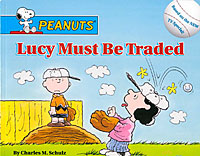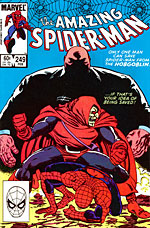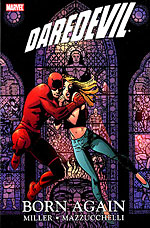>> Top Nine: Yusuf's Choice
>> Alphabetti Fumetti: S is for Shooter
More...

Bulent Yusuf joined Ninth Art back in 2004 with a look at online comics piracy, and has since gone on to become an essential part of the team, contributing not just columns and Forecast recommendations, but also devising and co-authoring the profile series Alphabetti Fumetti. In his own words, though:
Bulent Yusuf graduated from Starbucks University with a degree in Madonna Studies (Second Class), the highpoint of which was a 30,000-word thesis entitled 'The Semantic Pedagogy of Papa Don't Preach'. Thanks to this credible grounding in academia, he soon found work toiling in the bowels of a faceless corporation, worshipping Satan at the altar of the almighty dollar. When he's not selling his soul, he's touting his wares as a freelance journalist, sometimes meeting with success, sometimes not. He feels that he has been very privileged to write for an esteemed organ like Ninth Art.
PEANUTS
Charles Schulz
 It's my older sister's fault. She used to read PEANUTS when she was a teenager, and she had about thirty paperback collections lining her bookshelves. When I was a wee nipper, just barely able to read, I used to flip through the pages of each, fascinated by the layouts and the panels filled with word balloons and talking heads. I was especially taken with the recurring image of the little white dog with black floppy ears that slept on top of a hut.
It's my older sister's fault. She used to read PEANUTS when she was a teenager, and she had about thirty paperback collections lining her bookshelves. When I was a wee nipper, just barely able to read, I used to flip through the pages of each, fascinated by the layouts and the panels filled with word balloons and talking heads. I was especially taken with the recurring image of the little white dog with black floppy ears that slept on top of a hut.
When I finally did learn to read and understand, my interest grew stronger and more permanent. Here was a cast of characters who I innately admired and identified with, especially Charlie Brown - the round-headed kid plagued with anxieties and self-doubt, but also supported and held aloft by the love of his family, friends, and his dog Snoopy.
The PEANUTS strips are the first comics I ever read, and I am enormously fortunate that my introduction to the world of sequential art was the humane and life-affirming (but also very funny) penmanship of Charles M Schulz.
THE BEANO
Various
2000AD is often credited as being the first truly 'punk' British comic, but that's simply not true. The comic that had the most to say about life in 80s Thatcherite Britain was THE BEANO. Seriously. For a comic aimed at younger kids, this was a publication that was filled with class-war, corporal punishment and anti-establishment rhetoric.
Not convinced? Okay, well Dennis the Menace and The Bash Street Kids are the most obvious examples; juvenile delinquents running amok on the streets and in the classroom, demonstrating a healthy lack of respect for authority even after they got the slipper. Then there was Roger the Dodger, using crafty cunning and guile to shirk responsibility and cut corners; the kid was a free-market capitalist through and through. Last, but not least, was Lord Snooty and His Pals, a curious collection of upper class toffs and oddballs who inhabited a castle and seemed entirely divorced from reality.
I used to love THE BEANO for this weekly dose of subversion, and read it avidly from cover to cover. I was even a member of the fan club, which featured secret passwords and cool badges that I sported with pride.
Alas, the sheen was taken off a decade or so later when I was talking about it to someone in the pub. He made a convincing argument that Dennis the Menace was a homophobe because of the way he bullied his effeminate neighbour, Walter. It was hard to disagree with this assessment, and consequently my affection for the character became greatly diminished. However, there's no doubt in my mind that if there hadn't been a Dennis the Menace, there wouldn't have been a Judge Dredd.
SUPERMAN: MAN OF STEEL
John Byrne
When I was kid one of first films I'd ever seen was the Richard Donner-directed adaptation of SUPERMAN. I had seen a superhero movie before I'd ever read a superhero comic, and I had enjoyed it so much that I pestered my parents to buy me superhero comics whenever the opportunity arose.
Fortunately, you could buy comic books in a newsagent back then, so it wasn't hard to get a fix of four-colour goodness. Unfortunately, the Superman in the comics was markedly different from the Superman in the film. This was way before the reboot, and the character seemed to be trapped in another era entirely from the one on the screen. I'm sorry to admit it now, but I loathed the artwork of Curt Swan. It just wasn't... modern enough.
Which is why I'm grateful for John Byrne and this mini-series. Nearly ten years after the film was released, he had the vision to drag the concept kicking and screaming into the 21st century. He lifted a series of elements from the film, but also introduced some contemporary ideas like Lex Luthor as a corporate raider, and introducing Pa and Ma Kent to the supporting cast.
Today John Byrne is rightly reviled for his juvenile behaviour and offensive comments. But there was a time when he produced solid entertainment that was broadly accessible. To my mind, this was the best that Superman had ever been.
AMAZING SPIDER-MAN #249
Roger Stern and John Romita Jr
 In the early days, my comic book reading habits were dictated by circumstance rather than by choice. The newsagent would stock a large selection of Marvel and DC comics, so there were lots to choose from, but not always the same titles every month. Going home empty handed wasn't an option; I'd just buy whatever was available, which in one instance was ASM #249.
In the early days, my comic book reading habits were dictated by circumstance rather than by choice. The newsagent would stock a large selection of Marvel and DC comics, so there were lots to choose from, but not always the same titles every month. Going home empty handed wasn't an option; I'd just buy whatever was available, which in one instance was ASM #249.
This was the first time I'd read a Spider-Man comic. At least, I think it was. It might have been MARVEL TEAM-UP #136 featuring Wonder-Man. Anyway, this had a brilliant cover that just screamed for attention; a victorious Hobgoblin stands over a beaten Spider-Man at his feet, whilst looming over them both is the shadow of the Kingpin. The caption said it all: "Only one man can save Spider-Man from the Hobgoblin... if that's your idea of being saved!"
As soon as I'd finished reading this issue I quickly became hooked into the world of Peter Parker and the ongoing mystery as to the identity of his arch-nemesis, the Hobgoblin. Shortly afterwards I found reprints of the classic Stan Lee and Steve Ditko issues featuring the Green Goblin, and was naturally a little confused by the similarities between the two. Were they somehow related?
BATMAN: STRANGE APPARITIONS
Steve Englehart, Len Wein, Marshall Rogers et al
This is a fond memory. In fact, like everything else on this list, my favourite comics are the ones that I associate with particularly happy stages in my childhood. I think I was about ten years old, and was visiting some relatives; my cousin lent me this small paperback that reprinted a bunch of Batman comics from the late Seventies. As soon as I opened it I was hooked, and had to go sit in a corner for several hours until I finished reading it.
It was gripping stuff, an epic thriller featuring the Batman's greatest villains; Dr. Hugo Strange, The Penguin, Deadshot, and an utterly demonic Joker. And lest we forget, there was also an incredibly sexy love interest in the form of Silver St Cloud. Hot diggity but was she fine.
The dialogue by Steve Englehart was noirish melodrama, and the artwork by Marshall Rogers and Terry Austin was atmospheric and gloomy. A number of scenes became lodged in my mind: the smoke-filled boardroom where a crooked politician declares war on the Batman; a surreal punch-up on top of a giant typewriter in a convention hall; a climactic chase across the rooftops in the midst of torrential downpour. These Batman stories were the definitive Batman stories, and nothing since has ever bettered them.
My cousin wasn't much of a comic fan, and he was kind enough to let me keep the paperback. Years later, I learned that the stories had been re-coloured and re-edited to fit the digest format, and it wasn't until they were reprinted in trade paperback as STRANGE APPARITIONS that I got to read them as they originally appeared. Funnily enough, I still like to refer to the shoddy little digest, because that's my most direct link to the exhilaration of reading these stories for the first time.
CALVIN & HOBBES: WEIRDOS FROM ANOTHER PLANET
Bill Watterson
I've already written about this one at length, but I absolutely love CALVIN & HOBBES. Whereas PEANUTS was something my sister introduced me to, this was a treasure that I had discovered all by myself, and consequently it was that much more precious. I first found it in the Daily Express (of all places), and then bought WEIRDOS FROM ANOTHER PLANET to read on a long car journey from London to Brighton. I've lost count of how many times I've thumbed through this particular book; it can still be relied upon to induce laughter and glee even when I feel at my most despondent.
CALVIN & HOBBES has a lot in common with PEANUTS - the philosophical debates, the bursts of slapstick, the fantasy sequences - but Bill Watterson is the better artist. Where Schulz was a minimalist with a quiet, steady style, Bill Watterson was a literary ventriloquist, traversing a staggering spectrum of genres, conventions and clichés to illustrate the lurid imaginings of a five-year-old boy. Truly, this was a comic strip that knew no bounds, not even the panels on the page.
There was something of an edge to it, too. Underlying the humour of this particular collection is Watterson's concern, expressed through Calvin, about the environment and the harm that we humans have wrought upon it. Calvin's solution is to hop into his cardboard box with Hobbes and some sandwiches and travel to Mars, where he hopes to start afresh, but ultimately he learns that we're going to have to try and repair the damage that we've done to our own planet first.
X-MEN: THE DARK PHOENIX SAGA
Chris Claremont, John Byrne and Terry Austin
Before Alan Moore and Frank Miller assailed the world of comics and beyond, the collaboration between Chris Claremont and John Byrne on UNCANNY X-MEN was considered the pinnacle of the medium. A superhero soap opera filled with love, betrayal and sacrifice, it certainly packs a punch, though it might feel a little dated now.
It's been included on this list because, whenever I grow exasperated with the burgeoning number of crappy X-titles in my local comic shop, I can look towards this book as a reminder of why Marvel's merry mutants are held in such great affection by the comic fraternity.
DAREDEVIL: BORN AGAIN
Frank Miller and Dave Mazzucchelli
 I'd like to point out here that I'm not a religious person. In fact, my feelings toward organised religion of any kind are those of extreme antipathy. I'm not exaggerating when I say that, thanks to religion, I grew up experiencing no small degree of hatred and discrimination, and in hindsight I find it outrageous that a load of superstitious mumbo-jumbo should have been allowed to dictate the course of my life and those around me.
I'd like to point out here that I'm not a religious person. In fact, my feelings toward organised religion of any kind are those of extreme antipathy. I'm not exaggerating when I say that, thanks to religion, I grew up experiencing no small degree of hatred and discrimination, and in hindsight I find it outrageous that a load of superstitious mumbo-jumbo should have been allowed to dictate the course of my life and those around me.
However, it's somewhat hypocritical that one of my favourite comics is a story that is explicitly concerned with a Christian perspective on sin and redemption. Go figure. I'm guessing that this is because, whatever the window-dressing might be, a great story is still a great story. Frank Miller demonstrates his skills as a storyteller in this tale (where previously he was most famous for his art) whilst David Mazzucchelli maps out the agony and the ecstasy with searing verisimilitude.
The plot is concerned with the systematic destruction of an individual. Every single aspect of his life - his friends, his job, his identity - is torn away until he's pushed to the brink of insanity and death. But our hero survives, and despite everything he's lost he realises that he's lost nothing at all. If anything, the experience has made him stronger than ever. It's a powerful tale, and an inspirational one too.
XENOZOIC TALES
Mark Schultz
This is a classic adventure romp inspired by the kind of pulp science fiction where men have chins of granite and women wear bearskin bikinis. And of course, there are drooling dinosaurs on every page. What's not to like?
But the most appealing thing about this series is the rocky relationship between the two lead characters. Jack 'Cadillac' Tenrec is a mechanic, respectful of nature and intent on preserving the status quo, whereas Hannah Dundee is a scientist who believes in technological progress. On that basis the pair are constantly at loggerheads, despite their obvious physical attraction, and the complexity of their interaction is constantly driving the story forward.
The monochromatic artwork and dialogue by Mark Schultz is deliberately old school, his approach not dissimilar to Wally Wood and his cohorts at EC Comics, but the theme of environmental devastation and the ways that human society would try to rebuild in its wake was much more modern and politicised. I thoroughly enjoyed reading it, and believe that if ever I produced a work of fiction, I'd probably strive to achieve something similar.

This article is Ideological Freeware. The author grants permission for its reproduction and redistribution by private individuals on condition that the author and source of the article are clearly shown, no charge is made, and the whole article is reproduced intact, including this notice.


